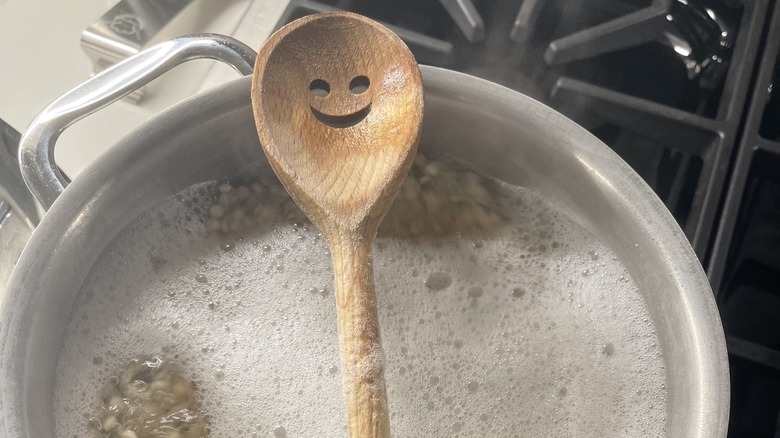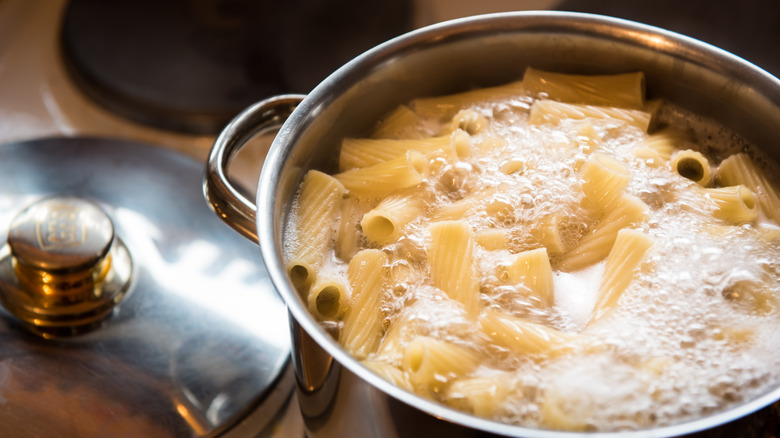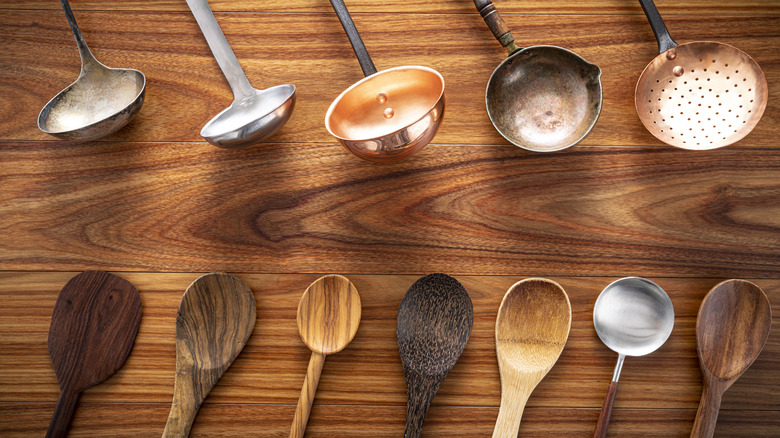The Simple Spoon Hack To Prevent Water From Boiling Over
Picture this: You're putting together the perfect recipe for penne alla vodka. After dumping the pasta into boiling water, you turn your back for a minute to chop some garlic, only to hear the steaming spatter of a dreaded boilover on the stove. It seems like bubbling pots of pasta and potatoes get out of control in no time, and it always makes a huge mess of the cooktop. If you want to skip scrubbing your burner bowls later and have a little freedom to walk away from the stove, place a wooden spoon or spatula across the span of the boiling pot. When the bubbles start to climb out of the rim, the handle of the spoon will break its momentum, keeping the sticky stuff where it belongs — in the pot.
Boilovers happen to everyone at some point, especially when you're cooking starchy foods, because the dissolved starch makes gooey bubbles that don't break down. With just a simple wooden spoon, you can buy yourself enough time to make it to the stove to stir or turn down the heat.
Why does a wooden spoon stop spillovers?
It seems like one minute you're standing over a simmering pot of water waiting for things to boil, and the next minute it's bubbling over. The old saying about watched pots never boiling is true — the second you turn your back everything starts happening. This is because when the temperature in the pot reaches a magical 212 degrees Fahrenheit, suddenly the heat needs to escape as steam. The water forms air bubbles, but the starch (from pasta, potatoes, rice, etc.) dissolved in the hot water coats the bubbles and they start to stack on top of each other like a soapy bubble bath. If you place a wooden spoon across the diameter of the open pot, however, you can stop the bubbles in their tracks.
The wooden spoon trick may seem like culinary magic, but it's actually science. The starchy bubbles are unstable, just like soap bubbles but a little stronger, so they can be popped. When they climb up the sides of the pot and come into contact with the surface of the wooden spoon, they collapse. This is because the surface of the spoon has a rough, dry texture, and it's a lower temperature than the steam captured inside. When the bubbles touch the spoon, they burst.
Only use wooden spoons
If you want to try the spoon hack on your next spaghetti night, it's important that you always use a wooden spoon. While there are lots of other utensils that can span the width of a pot, materials like plastic and metal can't work the same boilover miracle. Metal spoons and spatulas conduct the heat from the steam rising out of the pot, and the starchy bubbles will easily grow up and around them as if they were a part of the pot itself. Plus, a metal spoon will get very hot, and you run the risk of burning your hand by leaving it over the steam. Plastic spoons don't work much better, and they also get too hot. Unless you're using a silicone spatula, you may even melt the spoon. Wooden spoons don't conduct heat like plastic and metal, and even when they're wet their surface remains rough, which is what bursts all the bubbles. They won't also won't melt, and they don't tend to get so hot that you can't touch them.
Any type of wooden spoon will do, even the inexpensive bamboo ones you can get in the grocery store (which are not so coincidentally often sold in the pasta aisle). Next time you put a pot on the stove to boil, slap a wooden spoon across the top and see for yourself just how easy it is to stop a boilover in its tracks.


